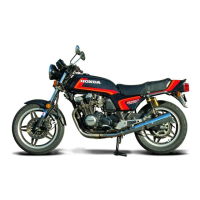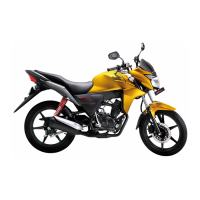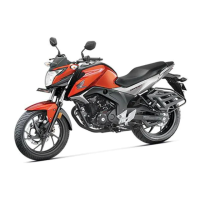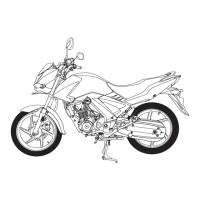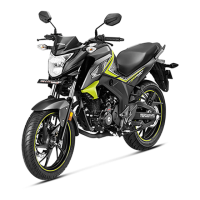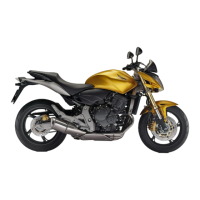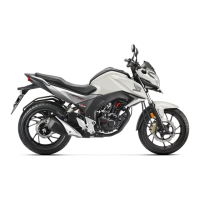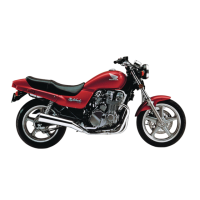Do you have a question about the Honda CB 300R 2020 and is the answer not in the manual?
Rules for enhancing rider safety and ensuring proper motorcycle operation.
Explanation of various safety labels found on the motorcycle for hazard warnings.
Essential precautions for riding, including protective gear and riding behavior.
Guidelines for safe riding, covering break-in period, brakes, and low traction surfaces.
Advice on adding accessories and making modifications to the motorcycle safely.
Instructions on proper loading techniques to maintain motorcycle stability and safety.
Visual identification of key motorcycle components and their locations.
Explanation of the motorcycle's instrument panel, displays, and indicators.
Description and function of various indicator lights on the instrument panel.
Description of various switches on the handlebars and their functions.
Operation and function of the motorcycle's ignition switch.
Step-by-step procedure for starting the motorcycle's engine.
Guidance on recommended shift points for smooth gear changes and optimal performance.
Instructions on how to refuel the motorcycle safely and correctly.
Information about helmet holders and the document bag for storage.
Highlights the necessity of regular maintenance for safety, performance, and longevity.
Provides a schedule for periodic inspections and service intervals for the motorcycle.
Covers essential pre-ride checks, periodic checks, and basic maintenance procedures.
Details on battery maintenance, cleaning terminals, and charging procedures.
Information on locating, inspecting, and replacing fuses to maintain electrical system integrity.
Guidance on checking, selecting, and changing engine oil and filter for optimal lubrication.
Instructions for checking and adding coolant to maintain engine temperature.
Procedures for checking brake fluid, brake pads, and adjusting the brake light switch.
Steps to check the side stand's operation and ensure it functions correctly.
Methods for inspecting and adjusting drive chain slack, wear, and lubrication.
How to check and adjust clutch lever freeplay for smooth operation.
Guidance on checking and adjusting throttle grip freeplay for proper response.
Instructions for cleaning the crankcase breather system.
Information on adjusting headlight aim and rear suspension settings.
Steps to diagnose and resolve issues when the motorcycle engine fails to start.
Troubleshooting steps for engine overheating indicated by the coolant temperature gauge.
Explains PGM-FI and ABS indicator lights and their troubleshooting.
Addresses fuel gauge failure indications and their resolution.
Guidance on emergency tire repair and wheel removal procedures.
Troubleshooting steps for common electrical issues like dead battery or blown fuses.
Diagnoses for unstable engine operation, possibly due to fuel pump filter.
Details about ignition keys, key tags, and making duplicate keys.
Overview of instruments, controls, ignition system, and odometer functions.
Guidelines for washing, polishing, and maintaining the motorcycle's appearance.
Instructions for proper motorcycle storage, including battery care.
Recommendations for safely transporting the motorcycle.
Advice on environmentally friendly cleaning and waste disposal practices.
Location and importance of VIN and engine serial numbers.
Information on exhaust, noise, and evaporative emission control systems.
Explanation of the catalytic converter and how to protect it.
Guidance on the use of oxygenated fuels and their potential impact.
Information on obtaining service manuals and other Honda publications.
Details on warranty coverage, recommended maintenance, and service procedures.
Key dimensions, weight, capacity, and engine specifications.
Technical data including tire size, air pressure, spark plug, and fluid capacities.
List of bulbs used in the motorcycle and their types.
Specifications for main and other fuses used in the motorcycle.
Torque values for various bolts and components during assembly/maintenance.
| Displacement | 286 cc |
|---|---|
| Transmission | 6-speed |
| ABS | Standard |
| Bore x Stroke | 76.0mm x 63.0mm |
| Compression Ratio | 10.7:1 |
| Final Drive | Chain |
| Front Tire | 110/70-17 |
| Rear Tire | 150/60-17 |
| Engine Type | Single-cylinder, 4-stroke |
| Fuel System | Fuel Injection |
| Front Suspension | 41mm telescopic fork |
| Rear Suspension | Pro-Link single shock |
| Front Brake | 296mm disc with radial-mount four-piston caliper |
| Rear Brake | 220mm single disc with single-piston caliper |
| Curb Weight | 317 lbs |
| Valve Train | DOHC, 4 valves per cylinder |
| Seat Height | 31.5 inches |
| Fuel Capacity | 2.7 gallons (10.2 liters) |
